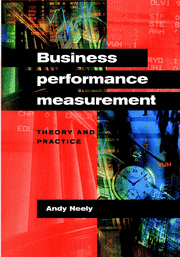Book contents
- Frontmatter
- Contents
- List of contributors
- Preface
- Part I Performance measurement – functional analyses
- Part II Performance measurement – theoretical foundations
- Part III Performance measurement – frameworks and methodologies
- 9 Performance measurement frameworks: A review
- 10 The critical few: First among equals as parameters of strategic effectiveness
- 11 Integrated performance measurement systems: Structure and dynamics
- 12 Why measurement initiatives succeed and fail: The impact of parent company initiatives
- Part IV Performance measurement – practical applications
- Part V Performance measurement – specific measures
- Part VI Performance measurement – emerging issues and trends
- Index
9 - Performance measurement frameworks: A review
from Part III - Performance measurement – frameworks and methodologies
Published online by Cambridge University Press: 06 July 2010
- Frontmatter
- Contents
- List of contributors
- Preface
- Part I Performance measurement – functional analyses
- Part II Performance measurement – theoretical foundations
- Part III Performance measurement – frameworks and methodologies
- 9 Performance measurement frameworks: A review
- 10 The critical few: First among equals as parameters of strategic effectiveness
- 11 Integrated performance measurement systems: Structure and dynamics
- 12 Why measurement initiatives succeed and fail: The impact of parent company initiatives
- Part IV Performance measurement – practical applications
- Part V Performance measurement – specific measures
- Part VI Performance measurement – emerging issues and trends
- Index
Summary
Introduction
It has been widely reported that there has been a revolution in performance measurement in the last 20 years. The enormous interest in measurement has manifested itself in practitioner conferences and publications as well as in academic research (Neely, 1998).
Research indicates that organizations using balanced performance measurement systems as the basis for management perform better than those that do not (Lingle and Schiemann, 1996). For this benefit to be realized, it is necessary for organizations to implement an effective performance measurement system that “enables informed decisions to be made and actions to be taken because it quantifies the efficiency and effectiveness of past actions through acquisition, collation, sorting, analysis, interpretation, and dissemination of appropriate data” (Neely, 1998, pp. 5–6). This definition is important as it indicates that a performance measurement system has a number of constituent parts:
individual measures that quantify the efficiency and effectiveness of actions;
a set of measures that combine to assess the performance of an organization as a whole;
a supporting infrastructure that enables data to be acquired, collated, sorted, analyzed, interpreted, and disseminated.
For the full benefit of measurement to be exploited it is important for organizations to maximize the appropriateness and effectiveness of measurement activity at each of these levels. This contribution is concerned with the second of these points, that is how an organization identifies a set of measures that reflects the performance it is trying to achieve. Numerous processes have been proposed that organizations should follow in order to design and implement performance measurement systems (Bourne et al., 2000; Neely et al., 1996).
- Type
- Chapter
- Information
- Business Performance MeasurementTheory and Practice, pp. 145 - 155Publisher: Cambridge University PressPrint publication year: 2002
- 39
- Cited by



